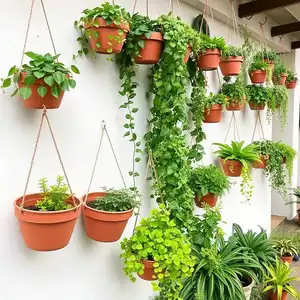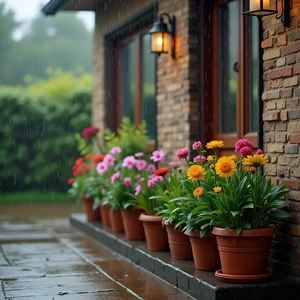
Elevated planters are a spectacular addition to any garden, balcony, or even indoor space, bringing height and structure to the area. However, their defined edges and rigid lines can sometimes feel a bit too formal or imposing.
This is where trailing plants come to the rescue: their cascading foliage softens the look of tall planters, partially draping over the edges and creating a beautiful waterfall effect.
Benefits of Trailing Plants
Trailing plants are a real boon for lovers of spectacular landscaping. Here are their key advantages:
- Incredible appeal. With proper care, they form magnificent cascades, transforming any space – whether it’s a balcony, terrace, garden, or a living room.
- Rapid growth and long-lasting flowering. Ampel plants grow vigorously, with flowering varieties entering the budding phase early. Some of them can also retain their colours until the first frosts, and the rest – through the entire winter.
- Proper use of space. Plants of this very type don’t require windowsills or garden beds, as they can thrive in hanging pots. Better still, they can be arranged in tiers to create multi-level displays – spectacular from every single angle.
- Versatile placement. In case you want to refresh the interior or garden design, trailing plants can easily be moved – just by simply relocating the hanging pots. This makes them perfect for those who prefer frequent updates.
Choosing the Right Trailing Plants for Elevated Planters
The overall key thing to remember is that your choice depends on the climate, light conditions, and the effect you want to achieve.
For instance, Pelargonium peltatum, with its vibrant blooms and lush foliage, thrives in sunny spots: Pelargoniums produce long, flexible stems that spill over the edges, creating a stunning cascade. Another excellent option is Ipomoea, a charming flower with a slight resemblance to Petunias. It can grow up really high with the right care, making it a fantastic choice for adding dramatic greenery.
Next, Lobelia erinus. It’s a true star in shady garden corners.
This easy-going flower fits perfectly into carpet beds and keeps delightful company with Matricaria, Marigolds, Salvia, Petunia, and Alyssum. In hanging pots, the trailing varieties look stunning – whether on their own or paired with other plants.
And for year-round greenery, species like Hedera helix are an excellent choice. This variegated Ivy, from the Araliaceae family, is adored for its lobed leaves and low-maintenance nature.
Feed it from March to October with a fertiliser for foliage plants, and it will thrive – beautiful, hardy, and forgiving of the occasional care mistake.
Definitely a great choice for busy or novice gardeners.

Design Tips with Trailing Plants
Now that we’ve covered specific plants for hanging displays, let’s talk about how to style them:
- Green ceilings are a big trend right now, whether fully or partially covered in foliage. To save space, opt for hanging baskets and pots with cascading stems – ideally, no more than five stops of varying sizes and heights – for a balanced look.
- Train climbing plants over a decorative trellis, ladder, or partition for a lush effect. Thus, flowering trailing varieties add extra charm compared to plain greenery.
- Framing arches, mirrors, and windows with trailing garlands enhances the shape of openings and other decorative features, therefore adding softness and structure.
- Tall stands and pedestals lend a stylish touch when topped with baskets of long, flowing stems. Brightly coloured plants work best here.
- Mixing live and artificial elements can create somewhat dynamic displays: larger vines make a striking base for arrangements, while small fresh bouquets add lively accents that are easy to switch up if needed.







